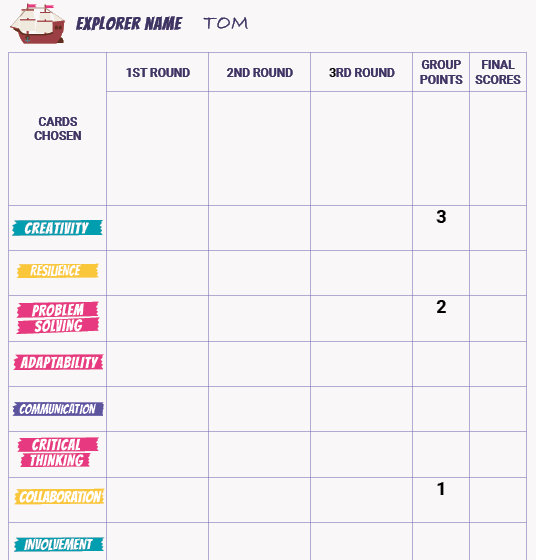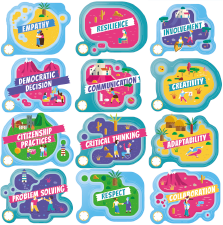5
GameOn: Assessing competences with Incluship
GameOn: Assessing competences with Incluship
Sobre
This playlist will guide you through the steps for using Incluship, the gamified tool created in the framework of the “GameOn” project for assessing the competences for inclusion that participants can develop during a game design process.
Complete the playlist activities to learn about:
- What is Incluship and what are its goals and intended use
- How to use Incluship, step by step
- Which competences can be assessed using Incluship
Jump aboard our Incluship and start your journey of discovery of this new gamified tool!
The international partnership “GameOn” created this playlist to promote inclusion, participation, and critical thinking through game design. Learn more about this partnership here.
Expert partners:
Nexes (ES) – the lead partner, Idealúdica (ES), Universitat de Barcelona (ES), BalkanIdea Novi Sad (SR), Nectarus (LT), Associazione Interculturale NUR (IT).
Co-funded by the Erasmus+ Programme of the European Union
Cover image from Incluship test carried out in Italy.
Atividades para concluir
Complete the following activities, earn badges and you will see your playlist progress updated
Sobre
This activity will guide you through the third and final step of using Incluship, the gamified tool that was created by Idealúdica and the partners of the “GameOn” project to assess inclusion competences acquired through game design.
This activity facilitates a final reflection about how the group has developed the inclusion competences. Each participant will sum the exploration points they’ve gained and then add them together to the competence islands boards and to the Incluship board. Everybody will then see if the group have achieved the goal chosen at the start of the game design or creative process.
This activity allows for a dynamic of cooperative reflection about what we’ve done as a group, and what we could improve. The activity, through the explorer journals, also facilitates a personal overview about the competences developed, the actions taken and which competences each person would need to improve.
This final session should be done only once at the end of the process and should last about 30/45 minutes, but it could last up to 1 hour depending on the size of the group.
1. The group evaluation
The session begins with a peer to peer group assessment.
Take all the exploration journals and redistribute them to all participants at random (be sure that no one has their own journal).
Each participant will read the name on the journal and will choose the 3 competences that, in their opinion, the person who owns the journal has developed the most during all the project activities. They will then assign 3, 2 and 1 points, respectively, on the 3 chosen competences, and write the points in the group points column.
For example:
If Mary receives Tom’s journal and believes that Tom, during the project’s activities, has worked the most on his Creativity, Problem solving and Collaboration competences, in this order, she will assign him 3, 2 and 1 points respectively and mark them in the right spaces in the “group points” column as shown in the picture below:

In turns, each participant will explain to other members of the group in which competences they have given points to the owner of the journal and the reasons for their selection.
Again, if working in a big group, this step can be done in small teams instead.
2. Global scores of the competence islands
All participants will then return the exploration journals to their owners.
Each participant will sum the total points gained through the evaluation activities and the group evaluation, for each of the 12 competences, and write the result in the “Final score” column. This will give each participant an overview of which competences they have worked the most on throughout the project and which skills, knowledge and attitudes have been the most significant in their learning process.
Finally, for each competence, you will add up all the points that all participants obtained and mark each total in the competence island boards, that you put up on a wall or board at the beginning. These scores will showcase the global exploration points obtained by the whole group in each competence island.

3. Global Incluship score - Achieving the goal
Now, go back to the 4 key competences that were chosen at the beginning of the process and sum together these values.
If the total amount of points is equal to or higher than the value of the challenge (calculated at the beginning and written in the Incluship board during the first session), it means that the group has achieved their goal and successfully built their Incluship!
If the total amount of points is lower than the goal, remind participants that this is part of a learning process and although the initial goal hasn’t been reached, there has been a lot of learning and competence development happening nonetheless.
4. Future plans
To close the last evaluation session, invite participants to share with the group their impressions, their feelings and where they will like to put in practice what they’ve learned and reflected on during the process.
In other words, where do they want to travel to on the Incluship they’ve helped to build?

To summarise…
- Do the peer to peer evaluation session, where each participant assigns points to another member of the group
- Each participant sums up their points in each competence island, then sum up the points of the whole group for each competence island and mark them on the boards
- Sum up the global points of the 4 key competences chosen at the beginning and check if the challenge score has been achieved
- Reflect on the learning and future plans
This activity is part of the wider educational effort of the international partnership “GameOn” to promote inclusion, participation, and critical thinking through game design. Learn more about this partnership here.
Expert partners:
Nexes (ES) – the lead partner, Idealúdica (ES), Universitat de Barcelona (ES), BalkanIdea Novi Sad (SR), Nectarus (LT), Associazione Interculturale NUR (IT).
Co-funded by the Erasmus+ Programme of the European Union
Cover image from Incluship test carried out in Italy.
Resources
Get activity badge
GameOn: Incluship step 3 Get this badge
The owner of this badge has learned in detail about the final step to implement Incluship in a learning group process and is now able to facilitate it.
Incluship is a gamified tool that was created by Idealúdica and the partners of the “GameOn” project to assess inclusion competences acquired by participants in a game design group process.
This activity is part of the wider educational effort of the international partnership “GameOn” to promote inclusion, participation, and critical thinking through game design. Learn more about this partnership here.
Você precisa concluir 1 tarefa para receber a patente
Tarefas
Task no.1
Evidence verified by: self-approved
If you haven’t used the tool yet, read the guide about the third and final step of implementing Incluship and share your thoughts on one or more of the following questions to earn the activity badge:
- What are the elements you found most interesting in the final step of the process?
- How and with what learning goals would you use Incluship in your educational work with your target group?
Task no.2
Evidence verified by: self-approved
If you’ve already used Incluship during a project, either as a facilitator and/or as a participant, think back on your experience and share your thoughts answering one or more of the following questions to earn the activity badge:
- If you have used Incluship as a facilitator, how did it go? What are your highlights from the experience? What were the challenges, if any?
- If you have used Incluship as a participant, what did you think of it? Was it useful to assess your competences using Incluship?
Habilidades
ESCO
#team-working
ESCO
#transversal competences/skills
ESCO
#promote inclusion
ESCO
#assessment methods
ESCO
#conduct self-assessment
Atividades: 4
Iniciado em: 11
Playlist completada em: 1
Tempo para completar: 2 horas 15 minutos
Compartilhar:
Organizadores
GameOn - Game Design for Inclusion
A Badgecraft roda uma infra-estrutura web para Cidades e Regiões de Aprendizagem. O consórcio Europeu desenvolve esta plataforma com o co-financiamento do programa da União Europeia Erasmus+
Plataforma
Alterar idioma:
